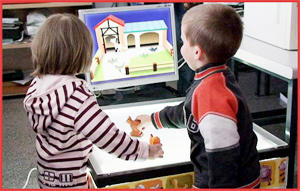The NIKVision team is part of the GIGA Group, at the Computing Department of the Zaragoza University (Spain). The team collaborates with the ChiCI Group in the University of Central Lancashire, Preston (UK)

NIKVision Tangible Tabletop Demo
NIKVision Tangible Tabletop Demo from Javier Marco on Vimeo.
"NIKVision is a Tangible tabletop in which toys control the games. NIKVision has been created by Javier MMarco, from GIG Group in University of Zaragoza, Spain." http://webdiis.unizar.es/~jmarco
Researchers for this project included Javier Marco, Eva Cerezo, and Sandra Baldassarri.
NIKVision Toys & Games
NIKVision Toys & Games from Javier Marco on Vimeo.
NIKVision, highlighted in the news in Spain (in Spanish)











